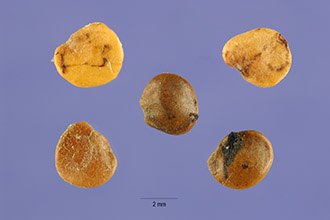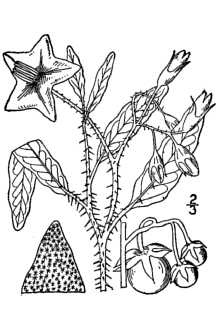Silverleaf Nightshade
Scientific Name: Solanum elaeagnifolium Cav.

| General Information | |
|---|---|
| Usda Symbol | SOEL |
| Group | Dicot |
| Life Cycle | Perennial |
| Growth Habits | Forb/herbSubshrub, |
| Native Locations | SOEL |
Plant Guide
Alternate Names
whiteweed, trompillo, white horsenettle , Use soil moisture sensors to measure the soil moisture of Silverleaf Nightshade.
Uses
Caution: Poisonous plant. Like most plants in the nightshade genus, silver-leaf nightshade is poisonous to cattle, but rarely consumed. Solanum is a huge genus with 1,200-1,800 species worldwide, but only 20 are found in Texas (all poisonous). The green portions of its domestic cousin, the potato, are also poisonous. Wildlife value of this plant is minimal.
Status
Please consult the PLANTS Web site and your State Department of Natural Resources for this plant’s current status (e.g. threatened or endangered species, state noxious status, and wetland indicator values).
Description
General: Nightshade Family (Solanaceae). Solanum elaeagnifolium, is a deep-rooted, native perennial, which rarely reaches a height of more than 3 feet. Silver-leaf nightshade gets its name from the short, white or silvery pubescence (hairs or fuzz) on the leaves and stems. This plant is found throughout Texas. Plants growing in humid regions do not normally have spines or prickles, while those found in arid regions are more commonly prickly. Leaves are alternate and entire. Leaf margins are normally wavy. Flowers are typical of the nightshade family (potatoes, peppers, and tomatoes). Solanum is the genus of the domestic potato. Solanum dimidiatum (western horse-nettle) is somewhat similar, but does not have the velvety appearance. Vegetatively, Croton capitatus (wooly croton, doveweed, goatweed), resembles silverleaf nightshade, though Croton is never armed. Unlike nightshade, Croton is very intolerant of shade. Brother Alfred Brousseau © St. Mary’s College @ CalPhotos
Distribution
This species is known from Washington and California to Maryland and Florida. For current distribution, please consult the Plant Profile page for this species on the PLANTS Web site.
Establishment
Adaptation: Silver-leaf nightshade is found on upland sites and appears to prefer loamy, droughty soils, but is found on virtually all soil types, except for deep sands. It is shade tolerant, becoming quite abundant under trees and beside farm buildings. Because the plant is poisonous and avoided by livestock, it tends to become more prevalent in overgrazed areas. Cultivars, Improved and Selected Materials (and area of origin) These plant materials are readily available from commercial sources. Contact your local Natural Resources Conservation Service (formerly Soil Conservation Service) office for more information. Look in the phone book under ”United States Government.” The Natural Resources
Conservation
Service will be listed under the subheading “Department of Agriculture.”
References
Davis, L. 2000. Texas plant fact sheet: Solanum elaeagnifolium. USDA, NRCS, Nacogdoches Technical Office #2, Nacogdoches, Texas. USDA, NRCS 2000. The PLANTS database. <http://plants.usda.gov>. 001206. National Plant Data Center, Baton Rouge, Louisiana.

